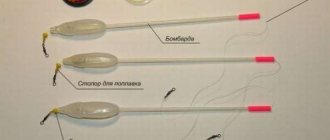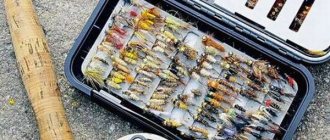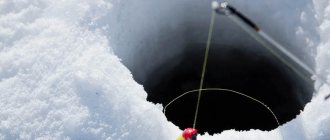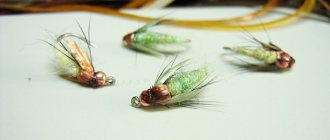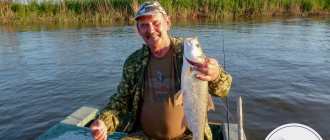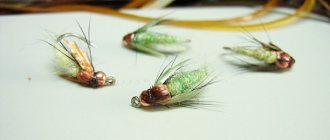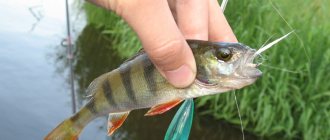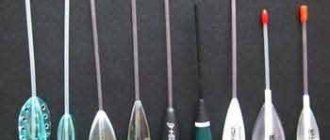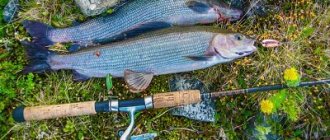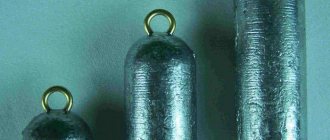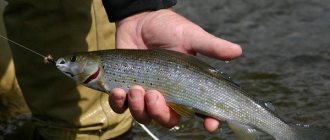Gear device
Bombarding for grayling is an alternative to fly fishing, allowing you to fish with dry and wet flies, as well as other light baits, with a simple spinning or feeder rod. Long casting helps to make the same float - bombard or sbirulino. In general, the tackle consists of the following elements:
- Rod. Here they use a long spinning rod of 2.7-3 meters, a medium feeder and even, in some cases, a four-meter lap dog. The bait test form must correspond to the weight of the bombard together with the rest of the load: fittings and bait.
- Coil. An inertia-free spool with a spool capable of holding 100-150 meters of fishing line. A high-quality friction clutch is the main condition for choosing a “meat grinder”.
- Fishing line. Since fishing is done at a long distance, the best option would be to use thin braid in combination with a shock leader, a piece of monofilament more than two rods long. The leader will allow you to throw heavier bombards, resist abrasion in strong places, and take on the load during forced fishing. In addition, it is easier to install equipment on nylon than on wicker.
- Bombard. A special float with an antenna and body, most often transparent. Depending on the fishing conditions, choose a sinking, neutral or floating sbirulino model.
- Accessories. Mandatory elements in the construction of gear are swivels and dampers - soft silicone stoppers.
- Leash. Made from thin braid or monofilament, depending on the fishing conditions, its length ranges from 50 centimeters to one and a half meters.
- Bait. Artificial bait or natural bait on a single hook.
The gear is assembled in the following sequence:
- A reel is placed on the selected fishing rod and equipped with the main fishing line - a braid of 0.10-0.14 millimeters.
- A shock leader - a monofilament with a diameter of 0.2-0.25 millimeters - is attached to the braid with a double sliding knot.
- A silicone stopper is mounted on the leader.
- Then the line is threaded through the bombard, so that the antenna is at the top, closer to the rod.
- After the sbirulino, a second stopper is placed to protect the swivel attachment point.
- A swivel is attached.
- A leash with bait is attached.
Fishing technique and tactics
The choice of bombard type and bait placement technique depends on the strength of the current in a particular body of water. If fishing takes place on a lake, then the usual fan casting of bait is used. If we are fishing on a river, we must first of all focus on the strength of the flow.
Fishing in still water
Fishing is easiest on a lake or similar body of water. The choice of a specific bombard depends on the grayling sites at a particular time of year.
In summer, when insects are active, use a dry fly or a popper with a floating bombard. To catch grayling in the fall, when the fish go deeper, neutral and then sinking models are used.
Slow current
The slow current allows for a variety of casts, almost like on a lake. But still, the best animation technique occurs when casting the fly downstream. First, we float the bait down as far as fishing conditions allow.
Then we begin to slowly pull it towards us, accompanying the rotation of the reel with small twitches of the rod tip. A bite can occur both on the raft and on the animation towards you, so you need to be careful. The choice of bombard type also depends on the grayling sites.
Special cases – fishing for mullet and trout with a bombard
The gear showed good results when fishing for mullet in the Black Sea. Traditional composition:
- rod up to 4.5 m long with a sensitive tip;
- spinning reel up to size 3000;
- main line with a diameter of 0.25 mm;
- slowly sinking bombard;
- bottom stop;
- triple swivel;
- fluorocarbon leader with a diameter of up to 0.18 mm and a length of about a meter.
Either a sea worm or mussel meat is used as bait. Vegetable attachments such as bread crumb or dough are used less frequently.
No less exciting trout fishing using such a float. However, such fishing is possible mainly on lakes and ponds where this fish is grown artificially.
Under natural conditions, trout are found in mountain rivers of shallow depth and fast flow. In them, the bombard turns out to be useless, since long casts are not required and the float itself can scare away fish in clear water.
Lures
Grayling can be caught using both artificial and natural baits. Below we list all possible options. Natural baits used:
- worms;
- maggots;
- bloodworms;
- caddisfly larvae;
- insects by season;
- fry of local fish.
Sometimes fishing for grayling is successful using vegetarian baits, such as:
Of the artificial baits, we note the following:
- fly fishing flies;
- poppers;
- minnow;
- small cranks;
- small silicone;
- micro spinner.
The choice of bait depends on the preferences of both the fisherman and the fish. In addition to your own preferences, you need to take into account what the grayling in a particular body of water currently eats. Then fishing will become unforgettable in terms of impressions and catchy in terms of results!
Bombard rig for grayling fishing
The most important thing in such gear is the bombard itself. A bombard is a special type of float that allows you to cast bait over long distances. They come in different sizes, and there are also floating and sinking ones.
You also need to carefully choose a fishing rod for such gear. If you take a lighter rod and a heavy float, then when casting you will simply break it. For this reason, it is important to choose a rod according to the parameters of the bombard.
The length of the rod also depends; the best length for such gear is three meters. If you take a shorter one, then most likely you will not be satisfied with such tackle due to the difficulty of casting.
Methods for catching grayling with a bombard
There are many ways to catch grayling using a bombard. But generally experienced scorers use three methods of casting. The first of them is along the current. The bombard is suitable for fishing for grayling both in autumn and summer; it is cast as far downstream as possible, and then the retrieval begins, pulling all the equipment towards it.
The second method of casting is carried out as follows. The bombard is thrown across the current. The line is then tensioned and held at the same tension. The bombard is carried downstream and the float with baits seems to describe an arc along the river, approaching the shore.
Well, the third way is to throw the tackle upstream of the river. When the float falls into the water and begins to float, the line is wound onto the spool at such a speed that the line does not sag in the water.
How to fish with a bombard
The range and accuracy of delivery of small baits allows you to fish large areas of water by casting the equipment from one point.
Important! Having identified a promising place, you need to throw it and pause to allow the bait to reach the desired depth level. When the float brought to the required horizon is stabilized, wiring begins.
Postings with bait stops, like jigs, twitching movements with a rod, tossing of equipment, ordinary wiring by winding the cord - everything is acceptable when using bombard fishing tackle. Improvisations with pauses irritate perch, pike and pike perch. The monotony of the wiring tempts rudd, bream and catfish to bite.
Hanging the bait in the water column perfectly attracts the picky and seemingly completely elusive asp to bite. Stepped wiring is the king of techniques when hunting for trout representatives of reservoirs. Fly fishing with a bombard is similar to the fly fishing technique. Having mastered this direction, your catches will include chub, grayling and saberfish as regular trophies.
Bombard fishing time
Catching grayling with a bombard begins as the air warms and insects fly out; you also need to take into account the fact that the water is sufficiently light after ice drift. By the time the water becomes suitable for fishing, the grayling will have already spawned and will have gained all its weight, so that in the first weeks of summer its feeding is especially active.
Most often, he stands on a current where there are underwater obstacles that form curls, and you can find a trophy in them. Another favorite place for grayling to stop is on rapids; the fish stands either a little higher or a little lower. You can catch grayling in the summer using a bombard both from the shore and across a ford; it won’t scare this cautious fish.
Most anglers prefer to fish in a ford; this increases the area where they can throw gear to catch the desired fish. If you decide to go fishing when the weather is sunny and warm, then it is best to do it in the morning or in the late afternoon at this time the bite is more active, and in cloudy weather the grayling bites all day long.
Lures for catching grayling with a bombard
Depending on how you plan to catch grayling in the fall or summer, on the surface of the water or in the depths, you also have to choose which fly to put on. For surface fishing, dry flies are used, those that float, and for fishing in the water column, they take either a wet fly or a nymph. Flies made from badger hair have proven themselves to be the best.
Taking into account the fact that grayling is a very cautious fish, flies should be as similar as possible to real insects. If the fish doesn’t like the fly or suspects something is wrong, then there won’t be a bite.
Varieties of flies for catching grayling
Taking into account the peculiarities of grayling fishing, initially everyone began to actively hunt for various insects, but were faced with the problem of storing bait. Not all insects tolerate being stored for several hours well. A good solution to the problem was to get bait directly at the fishing spot, but another difficulty arises - it is difficult to start fishing before dawn, since it is difficult to catch bait at night.
Read more
How to catch crabs?
Artificial flies for catching grayling do not have these disadvantages and also have additional advantages:
- universal in use;
- manufactured in suitable size and weight;
- are firmly fixed on the hook, the nozzle will not slip during casting;
- have durability;
- if made by hand, all materials are cheap.
We recommend using exclusively hand-made flies for catching grayling, since the predator tends to tightly grab the bait, making its further removal problematic.
In total, there are two main groups of flies designed for different fishing methods and seasons.
Artificial flies for grayling fishing are durable and versatile in use
What flies are needed for catching grayling:
- dry, high. Designed to imitate insects blown into a pond by the wind or fallen from above-water vegetation. In appearance they resemble wasps, dragonflies, butterflies, flies, and various moths. A characteristic feature of dry flies is the use of a fluffy body. Usually, during the manufacture of flies, bird plumage and animal fur are used. We recommend using small hooks; it is better to buy them to ensure structural strength, but homemade options are also suitable;
- wet, cargo. Also interesting are cargo flies for catching grayling, which are distinguished by imitation of various aquatic insects, nymphs, pupa, tadpoles, caddis flies and other small things floating on the surface of the water. When installing the equipment, we use a minimum of feathering and fluff, and we use relatively thick and large hooks. Additionally, we can use thick wire weights.
It is important to understand the behavior of grayling depending on the season in order to choose the right bait:
- we imitate the insects that are most numerous in a particular season. In the spring, it makes no sense to use insect species that emerge in late summer. Rare species are also not needed, since grayling may be frightened by the sight of an unfamiliar bait;
- catching grayling with a high fly is more effective in the warm season (May and summer), since in early spring it lives in the bottom layers of water. The reason for this behavior is the lack of food on the surface of the water. In spring, it is better to use imitation worms, river mollusks, eggs, caddis flies, small crustaceans, caddis flies;
To choose the right bait, it is important to understand the behavioral characteristics of the fish.
- in April and early May, fishing methods using a bombard with sinking flies are more effective. On almost all bodies of water, variants that imitate the mayfly butterfly (flying out in the middle or end of May) are popular. We can produce it in both riding and sinking types. If the time of year is chosen incorrectly, the predator will not be tempted by this bait;
- When selecting equipment, current should be taken into account. In reservoirs with a fast flow of water, the riding fly should not go astray; an option is made that most accurately imitates natural baits;
- In summer it is better to go out for grayling on small rivers and pools on rifts, where it goes well for flies, butterflies, amphipods and ants.
We recommend attaching 3-6 leashes to the main line at the same time, attaching different flies to each. This kind of acquaintance with the reservoir is the fastest and most successful; you will be able to immediately identify catchy and useless baits.
Fishing rod rig for catching grayling with a bombard
Tackle for catching grayling with a bombard must include such mandatory elements as:
- Rod. It is selected taking into account long-distance casting; it is optimal to choose 3-6-meter rods. Depending on the weight of the sbirulino, the test is selected; as a rule, it ranges from 40 to 60 grams.
- Coil. It is more effective to choose spinning reels, and up to 100 meters of 0.25 mm fishing line should fit on it.
- Fishing line. You can use monofilament and braided fishing line. Thanks to their ability to stretch, braided lines are great for long-distance fishing. For close-range fishing, it is better to choose a monofilament line that can dampen the jerks of the caught fish.
- Bombarda or sbirulino. Selected depending on the fishing distance. The optimal weight of the equipment is considered to be up to 40 grams.
- Leash. The choice of leash is determined by the type of fish you are going to catch. Often a small piece of fluorocarbon line is used.
- Swivel. Using size 14 to 20 swivels helps reduce the chance of bombard line twist, which is often seen with spinners and flies.
- Hooks. You should choose strong and sharp hooks. When using bait of animal origin, it is better to choose long hooks with a wide hook and a small barb. The size of the hook is determined by the size of the bait and the type of fish being caught.
What equipment is needed to use the bombard?
To use bombards, you can purchase special fishing rods in the store, the length of which varies from 3 meters or more. They are, as a rule, flexible and soft blanks that allow long-distance casting of bait and smooth landing of caught fish.
To use sbirulino, most experienced fishermen recommend purchasing lightweight rods with low weight.
It is worth noting that when choosing a fishing rod, you should pay attention to its test indicators, which should be suitable for the weight of the bombard used.
For example, when the mass of sbirulino is 45 grams, then the test of the rod used should be the same, or better yet 15-20% more.
As practice shows, to use this equipment, it is preferable to use medium-action spinning rods.
Build the form
The length of the rod is selected taking into account the size of the leash used. For example, if a 150 cm leash is used when fishing, then the total length of the rod used must be at least 3.5 meters.
Bombard installation and equipment
Important! When using a bombard, the total length of the selected rod should be 2.5 times the size of the leader. Otherwise, it will be difficult to cast bait over long distances. Also, when using the sbirulino method, it is recommended to use spinning reels with a spool diameter of 2000 - 3000.
Installation of a purchased bombard
Installation of such equipment as a bombard does not take much time, but it will require extreme care and attentiveness from the fisherman. Sbirulino is mounted using two methods:
- removable (rare);
- one-piece method (is the most common).
When using the so-called removable method, after the stoppers you need to install special swivels along with fasteners. This is necessary for subsequent replacement of equipment when fishing.
In most cases, fishing enthusiasts use the so-called one-piece rig. To do this, you need to pull the cord into 1 stopper. Then the cord must be inserted into the bombard from the side where the long tube is located.
Then the cord needs to be threaded through the 2nd stopper. At the final stage of installation, you need to attach a swivel to the equipment. To prevent the fluorocarbon leader from constantly twisting during casting, it is recommended to install 2 swivels.
Installation of sbirulino
DIY bombard installation - video instructions:
How to make your own bombard
You can make bombard fishing tackle yourself at home. To do this you will need the following materials and tools:
- knife or sharp blade (you can use a stationery knife);
- small vice (used for fixing materials);
- awl (alternatively, you can use a screwdriver);
- sandpaper;
- a small piece of foam;
- epoxy;
- float (you can take a broken, out of order heavy float);
- a small piece of plastic (a container from a children's toy sold with a Kinder surprise will do).
What you need to make a bombarda with your own hands
To make a bombarda, you first need to take a small piece of high-hardness foam.
You will also need an empty, used ampoule from a regular gel pen. Then, using a knife, you need to cut out a rectangular shape from foam plastic, the length of which should be about 6 cm. At the next stage, you need to sharpen the resulting workpiece using sandpaper so that it takes an oval shape.
Then, using an awl, you need to make a through hole in the center of the workpiece. The diameter of the hole must correspond to the size of the ampoule. Then you need to coat the ampoule with glue and insert it into the hole in the workpiece. It is worth noting that in this case, glue brands are used that are not capable of damaging or corroding the foam.
Then, using lead, you need to bring the equipment to the required weight for casting bait over long distances.
You can also make sbirulino from a Kinder Surprise container. To do this, you need to take a tube whose diameter is 1.5-2 cm. Alternatively, you can use a wide gel or simple pen.
Bombard from under Kinder
You need to pour epoxy into the cavity of the tube and let it harden. Then, you need to carefully knock out the epoxy resin from the handle and sand it thoroughly. Then the Kinder Surprise container is placed in a vice, and a hole is made in its central part. At the final stage of manufacturing, you need to place a tube in the hole and secure it with glue or epoxy.
How to make a bombard fishing tackle with your own hands:
Methods for catching grayling with a bombard
You can catch grayling using a bombard in different ways, of which there are a huge number, but the most commonly used are the following:
- along the current - the bombard is thrown downstream, and then all the equipment is pulled towards itself;
- across the current - the sbirulino is thrown across the current, while the fishing line is stretched, and the tackle with bait is carried closer to the shore, describing an arc;
- upstream - cast upstream of the river, when the float hits the water, the fishing line is reeled in so that it does not sag.
When fishing for grayling with a bombard, use a 4-5-meter rod with guides and a weight of 30-40 grams; it is better to choose a spinning reel with a line up to 0.19 mm.
Scope of application
Sbirulino is used to deliver bait used in catching fish to distances far from the coastline. In addition, the bombard allows you to cast the bait you are using to different depths, which is often important when catching fish that are actively moving throughout the entire horizon.
The sbirulino method makes it possible to use a wide variety of baits: worms, maggots, and also, when catching predatory fish, flies, spinners, micro rubber.
Even the smallest spinners can be thrown quite far with the help of sbirulino
Thanks to the use of a bombard, the bait used can be thrown into the water at a greater distance relative to the fisherman’s position. For example, thanks to a bombard, an angler can cast flies when fishing for grayling or trout at a distance of 30 to 70 meters.
Lures for catching grayling with a bombard
The choice of fly for grayling depends on the fishing method - on the surface of the water or under water, as well as on the time of year. Surface fishing requires the use of dry flies that are able to float on the water, and underwater fishing is carried out with a wet fly. Badger hair is an excellent material for bait.
At different times of the year, fish prefer certain foods. To select the optimal bait, you should choose either natural bait or its imitation.
To catch grayling, different types of bait are used:
- Animals - maggots, bloodworms, worms, larvae, various flying insects, adults are excellently caught with fry or frogs.
- Vegetable - bread, different types of dough, grains of corn, peas or pearl barley.
- Artificial ones - silicone fish, small spinners, wobblers, flies and foam balls have proven themselves to be excellent.
Rating of the best flies for grayling
It is impossible to create a single rating that would be equally fair, since any fly may not work in a body of water. The correct way to determine the best fly for grayling fishing is to evaluate its suitability for natural food in a particular season.
Read more
How to catch crayfish?
Rating of the best flies for grayling
Which fly is best to attach to a fishing line:
- Many experienced anglers agree that the best fly is a caddis fly imitation. This variety is applicable on mountain rivers and is successfully used on Karelian lakes. It performs well throughout the season, since caddisfly is included in the diet of grayling throughout almost the entire year. Even with its small dimensions, the caddisfly copy plays well on the water and accurately replicates the movements of insects;
- mayflies show the best results in spring, but it is important to catch the flight of these butterflies. Wiring fishing is possible and proves catchy in almost any weather conditions. Bycatch is small taimen and whitefish;
- The nymph is most attractive in the summer. Now grayling swims in the water column, less often sinks to the bottom, sinking equipment leads to aggressive and confident bites. Additionally, the nymph is good in autumn fishing before the onset of freeze-up;
- universal bait - bunting larva. Its imitation causes bites throughout the season. If we use a classic fly, it also catches trout, whitefish, ide, and chebak. The only difficulty with the bait is the need to select the correct color for each season;
- Caddisfly pupa often leads to the capture of trophy specimens. We use it as a bait on float rods, lowering the bait through the water. Usually bites come at the last moment: on a riffle or in a still pool.
